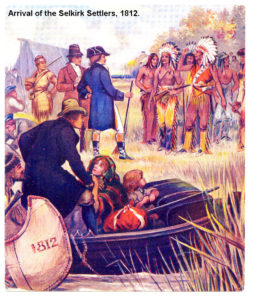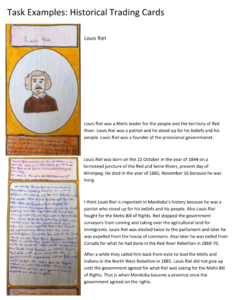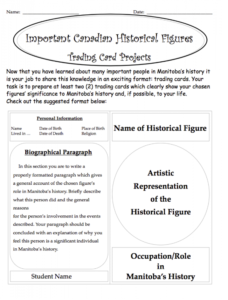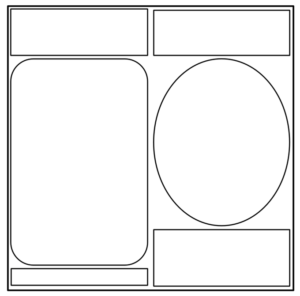At the end of 12 years of studying history in school, students should have more than an accumulation of memorized dates and facts. Students need to understand their lives in the historical context of the past.
Historical Thinking fosters a new approach to history education. It involves a shift in the teaching and learning of history. Historical Thinking is central to history instruction and students should become competent Historical Thinkers as they progress through the grades.
Historical Thinking Concepts
The six Historical Thinking concepts that provide a way of understanding history and communicating complex ideas are:
- Establish historical significance
- Use primary source evidence
- Identify continuity and change
- Analyze cause and consequence
- Take historical perspectives
- Understand ethical dimensions of history
* See below for details and lesson ideas
Websites about Historical Thinking
- Historical Thinking Project at http://historicalthinking.ca/
- The Big Six Historical Thinking Concepts
- Teacher Notes at http://www.edu.gov.mb.ca/k12/cur/socstud/foundation_gr8/tns/tn1.pdf
- Manitoba Social Studies Curriculum at http://www.edu.gov.mb.ca/k12/cur/socstud/
- Historical Thinking at http://historicalthinkingresources.weebly.com/
- Concept 1: Historical Significance
- Concept 2: Primary Source Evidence
- Concept 3: Continuity and Change
- Concept 4: Cause and Consequence
- Concept 5: Historical Perspectives
- Concept 6: Ethical Dimensions
Concept 1: Establish Historical Significance
The past is everything that ever happened anywhere. How do we make decisions about what we wish to remember as history?
Historically significant people and events include those resulting in great change, over long periods of time, for large numbers of people. Whether or not a person or event is significant depends upon one’s perspective and purpose.
Historical people and events can acquire significance if we can link them to larger trends and stories that reveal something important for us today. The story of a Ukrainian family member, who immigrated to Canada 1897-99, may become significant if it is told in a way that illustrates the larger history of immigration in Canada at that time. In that way the insignificant becomes significant.
Example: Why was Chief Peguis historically significant?
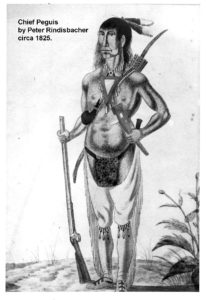
Saulteaux man, possibly Chief Peguis, Sketch by Peter Rindisbacher, Archives of Manitoba [click to enlarge]
Chief Peguis was designated as a person of historical significance on April 11, 2008. Chief Peguis was designated because:
- He used his skills as a hunter, warrior, diplomat and leader to protect the rights and interests of his people and to ensure the success of the Selkirk settlement.
- He was one of the five signatories to the Selkirk Treaty (1817), the first land treaty negotiated between colonists and Aboriginal people in Canada
- After much deliberation, he became the founder of the farming community which, in the face of poverty and starvation, assured the survival of his people
- During the era in which there were enormous pressures on First Nations to assimilate and convert, he dedicated his life to maintaining his peoples’ culture and beliefs by negotiating the preservation of traditions while adopting new ways.
Cultural Resource Management, Manitoba Field Unit – Parks Canada
Activities
Historical Significance Questions Samples
- Hierarchies
First Peoples artifacts:
Select 10 most important artifacts in order and justify why they are the most significant to the First Peoples in that area.
Select one artifact from one cultural area and share why it had the most impact on their First People. - Precis:
Exploration: Motivations and Dangers
Use pictures or words to explain the motivations and dangers at the time of exploration. Analyze and discuss why the students chose to draw or write those dangers and motivations. Did they have deep consequences for many explorers over time? - Why something is important:
Why was Henry Hudson and his voyage a historically significant event? What did it lead to? Did something great come out of his “failed” exploration? How did his voyage have deep consequences for many people, over a long period of time? - Isolation:
The fur trade led to many new things in the growth and development of Canada. What events/ activities did it lead to, and does it still have an impact on life in Canada today? - Counter –possibilities:
Had circumstances been different, and the Americans had won control over Canada, what would Canada look like today? How would things be different? Would it have long lasting consequences on the life we have in Canada? - Comparisons:
Which do you think was more historically significant in the growth of Canada? Giovanni Caboto’s arrival at his New Found Land or Jacques Cartier’s arrival in Stadacona? Clarify and illustrate why you have made that decision.
Activity: Significance Card Activity
- Before the activity create brief information cards about either people or events that the students have studied. Include a picture with correct citation and a brief synopsis of the person’s contributions or the ramifications of an event.
- Divide the students into groups.
- Study the Significance Task cards
- As a group discuss the information on the cards. Then together decide which person or event is the most historically significant and why.
- Rank the events ( people ) from most to least significant or choose the most historically significant person or event.
- Share and justify your ranking either orally or on chart paper.
This is a review activity that can also be used to assess the student learning at the end of a unit of study. In higher grades it could also be a written examination question.
Activity: Examples of Grade 4 and Grade 11 Historical Significance Questions
Grade 4
- Which of the following Aboriginal contributions do you feel was the most significant to the history of Manitoba?
- Which factor of European contact had the most influence on Aboriginal life?
- Give students a list of 4 to 5 people or events in Manitoba history. Have them decide how they would order them from least to greatest historical significance.
- Record the contributions of the ethnic or cultural groups to the history of Manitoba
- From the list below who was the most historically significant person in the development of Manitoba? Give reasons for your choice.
- Louis Riel
- Chief Peguis
- Lord Selkirk
- Nellie McLung
- Thanadelthur
- voyageur
- Create a list of dates and events related to the history of Manitoba. Students select the event they feel is most significant.
- From a list of historically significant people select the person you feel is most significant and design a new coin to commemorate their life.
- In two sentences what do you think were the two most significant effects of European settlement on the Aboriginal people.
Grade 11
- Compare the historical significance of the defeat of the Meech Lake Accord with the loss of the 1995 Referendum. Which was more significant to the separatist movement?
- Which of the following groups do you think made the most significant progress in their struggle toward cultural, political and economic rights?
- First Nations
- Metis
- Inuit
- Which wave of immigration is the most historically significant when considering Canadian Society and identity?
- Rank in order of importance 4 natural resources in Canada that have shaped our history.In a well written paragraph justify your ranking.
- Since colonization First Nations, Metis and Inuit have struggled for cultural, political and economic rights. Choose one of the three struggles which you think is most significant today and why?
- The following events are contributing factors to potential Quebec separation. Rank them in order of importance and explain your reasons:
- siege of Quebec
- October crisis
- election of the Parti Quebecois in 1976
- conscription crisis.
Activity: Three Panel Historical Significance
| Impact | Description | Revealing |
|
|
|
Grades 5-6 Trading Card Activity
* Created by teachers J. Schrofel of École Selkirk Junior High in Selkirk, Manitoba
and K. Cooke of Robert Smith School in Selkirk, Manitoba
| Trading Card Example | Trading Card Instructions | Trading Card Template |
|---|---|---|
| Download trading card example | Download trading card instructions | Download trading card template |
Concept 2: Using Primary Source Evidence
When detectives look at a crime scene to determine what has happened they must look at all of the evidence. Historians must also look at evidence or clues when they wish to find out what happened in the past. Evidence, that was created in the time of an event, is termed primary source evidence. This may include photos, artwork, letters, maps, newspaper articles, objects and much more.
We can categorize primary evidence in the following way : written text, images, artefacts, and oral records.
To gather evidence from primary sources we must look at them and think about their historical context and then make inferences from them. This will then help us to realize what was happening at the time that they were created.
Note: A history textbook is not a primary source. It is only a place to look up information.
Primary Sources
There are four types of Primary Sources:
- Written
- Images
- Oral History
- Artefacts
Websites about Primary Sources
- What is History?
- Then/hier Teaching Resources
- Collections Canada: The Learning Centre
- Using Primary Documents in Social Studies and History at http://www.learnalberta.ca/content/sspp/html/pdf/using primary documents in social studies and history.pdf
- The Teaching with Primary Sources Journal
- Comparing Primary and Secondary Sources
- 100 Objects that can Teach Children About History of the World – The Telegraph at http://www.google.com/url?q=http%3A%2F%2Fwww.telegraph.co.uk%2Feducation%2Feducationnews%2F11069902%2F100-objects-that-can-teach-children-about-history.html&sa=D&sntz=1&usg=AFQjCNFk5WXLR5hu1sznq08c3THnVHn2pg
- 100 Objects that can Teach Children About History of the World – Mail Online News at http://www.dailymail.co.uk/news/article-2741174/The-100-objects-help-bring-history-life-Artefacts-including-Guy-Fawkes-lantern-700-000-year-old-hand-axe-Sutton-Hoo-helmet-form-project-liven-lessons-schools.html
Concept 3: Identify Continuity and Change
A significant history concept that students need to grasp is identifying continuity and change over time. This involves considering how people, ideas, and places have stayed the same and/or changed over time. There are many events happening at any given time. Some change rapidly and others remain relatively ths same. When students understand the concept of continuity and change they realize history is not just a list of events.
Also, we need to look for change where it is least expected and look for continuities where we think there has been change. We can identify continuity and change by comparing a point in the past to one in the present or by looking at two points in the past. The ideas of progress and decline help us to evaluate change over time.
Activities
Activity: Using a Timeline (Continuity and Change, Cause and Consequence)
Why a Timeline?
Students often encounter little bits and pieces of history out of context and unconnected to larger historic themes. Consequently, students don’t develop a sense of historic era and they don’t connect individual events to larger movements and themes. This affects the students’ grasp of history topics and restricts students’ engagement in critical analysis.
Timelines help students understand the order of historic events, and helps students place new events and figures in relation to those they’ve already studied. They provide a visual aid for identifying cause and effect relationships between events, and a visual prompt to activate student prior knowledge. They allow students to recognize how historic events, eras and topics overlap in time as well as which events have continuity or have changed. They can be used to categorize similar or related events into themes, eras, and topics, and to help students compare elements in different time periods
Activity
In this ongoing activity, a timeline is collectively constructed by students. It may be made of butcher paper and covered in student drawings, primary sources, and recipe-sized cards noting laws and events. The main classroom timeline may be supplemented by smaller posterboard-sized lines that include only a few elements, such as changes in farming or in environmental regulation over time, or a chronology of legislation related to voting rights and disenfranchisement. But timelines should always be constructed by students so they reflect the students’ own learning.
Preparation
- Cut a long strip of butcher paper. Your class timeline should be displayed as prominently as possible in your room, and should be easily reached for adding new elements. If it’s hard to reach, you’ll be less likely to add elements daily. But if you don’t have space in your classroom for your timeline, try hanging it in the hallway near your class.
- In bold colored marker, place marker dates on the paper. These will be determined by the course content. Be sure to leave space for dates before and after the time period your class will explore, however, as your class will almost certainly encounter events that precede and follow the designated beginning and conclusion of your unit explorations.
- Decide how the class will display elements on the timeline. Will you ask for volunteers to illustrate events that go on the line? Will you ask the class to vote on how they wish to illustrate various elements—with a student illustration, a copy of a primary source, a historic image or…? Will you decide each time how an element that goes on the line will be represented?
All Ready
Start your classroom timeline at the beginning of the school year. Add to it throughout the year.
At the conclusion of an exploration of a significant event or person, ask the class if they would like to include that person or event on the class timeline. Tape the representation of the new element to the timeline, with a date and title prominently visible. When posting a person’s life rather than a single action by a person, you may wish to list dates of birth and death.
Every day or two, begin your history study with a review of the timeline. Settle your students on the floor in front of the line and invite them to do a silent “walk and talk” of the events on the line. Allow a minute or two for this activity, and then invite a student to stand and do a walk-and-talk aloud (see video).The students don’t need to account for every element on the line; they should just use the elements as prompts to tell a story about a particular era or theme, or inventory various things that were happening during the same time period. Let students finish before correcting any mistakes they may make in their storytelling.
When deciding which elements to put on your timeline, it’s better to err on the side of generosity than stinginess. The more elements on your line, the better it reflects your class’s learning, at least if you are engaged in rich history explorations. But don’t limit your dates to events you explore in formal history lessons; include elements from other disciplines as well. Language arts, science, music, math; if you encounter a historic topic in one of those areas, add it to the class line. If a student finds something at home that relates to history, invite them to add it to the line. A dynamic, full-to-the-brim timeline is a sign of a class that’s engaged in history full- tilt.
As your class explores history, allow and encourage your students to view and reference the timeline spontaneously to situate new evidence in relation to what they’ve already studied, or to infer the timing of a new historic element for which they have no date.
Watch this video and listen to a student walk and talk her way through her class timeline. http://www.youtube.com/user/Bringinghistoryhome#p/u/8/HIXsh0YjTuwr
Activity: Using Photographs to Teach Continuity and Change Over Time
A significant history concept that students need to grasp is Continuity and Change Over Time. This involves considering how people, ideas, and places have stayed the same and changed over time. While explaining this concept is a start, we have to remember that many students are visual. Luckily, there are picture sets that exist which allow us to guide students toward understanding this concept.
Picture Sets
The Critical Thinking Consortium at http://sourcedocs.tc2.ca/history-docs/topics/chinese-canadian-history.html
Canada Online at http://canadaonline.about.com/od/historyphotos/
Red River North Heritage (for local history) at https://redrivernorthheritage.com/category/photos-videos/photogalleries-photos-videos/
Virtual Heritage Winnipeg at http://www.virtual.heritagewinnipeg.com/
How might I use a picture set within a learning activity?
If students are given this set of pictures, they might initially organize them on a timeline. This opportunity deepens their sense of chronology and how timelines are used by historians. For younger students who are still grasping concepts of time, they might add the birthdays of major family members or when particular items were invented. Adding these elements help students to build context for time periods. Finally, allow students to create a simple T chart with:
- What appears to stay the same over time?
- What appears to change over time?
This gets students actively involved in the historical process/historical thinking and creates an entry point for every student to apply the concept of Continuity and Change Over Time to their learning of history. Students might add details that are complex or details that may appear, initially, surface level. The open-ended nature of the learning activity allows students of all learning levels to engage in the thinking and participate in the discussion of what was observed.
Keep your eyes out for additional picture sets that you might use.
Websites
- http://blog.americanhistory.si.edu/osaycanyousee/2010/10/exploring-continuity-and-change-through-the-history-of-the-bicycle.html
- http://forums.atozteacherstuff.com/showthread.php?p=1007061
Activity: Teacher submitted Continuity Questions for Early Life and Settlement
(Influence of natural environment in Manitoba, interactions between the Selkirk settlers and Aboriginal peoples, impact of European settlement on Aboriginal communities in MB)
The impact of European settlement influenced and changed life for the Aboriginal communities in MB.
Change
- How did things change?
- What changed?
- What are the positive and negative aspects of these changes?
- How quickly did the changes happen?
- Were some of these changes difficult for the Aboriginal communities?
- Were some of these changes easy for the Aboriginal communities to accept?
- Are these changes still happening today?
Continuity
- Did some aspects of life for the Aboriginal communities not change?
- What remained fairly constant?
Submitted by:
Kim Cooke
Grade 5 Teacher
Robert Smith School
Activity: Continuity and Change Task using the book A Street Through Time
A Street Through Time is an illustrated book that follows the same street over fourteen time periods from the stone age to the present.
Preparation
- Copy the pages from the book A Street Through Time. Make sure to cover the page numbers. Copy as many sets as you need to give one set per group.
- Divide the students into groups.
Group Directions
- Study the pictures of the same street from the book A Street Through Time
- As a group discuss what is the same and what is different in each picture.
- Decide the chronological order of the pictures based on what is the same and what appears to be different.
- Share the order you decide upon. Give reasons for your choices.
Resources
- Millard, Anne. Illustrated by Steve Noon. A Street through Time. New York, U.S.A.: Dorling Kindersley, 1998. 48 page hardcover book.
- A copy of the description of each page can be downloaded as a pdf here. This is helpful for further discussion of the pictures after the group work is complete.
- There are other books with a similar format; A City Through Time, A Port Through Time.
Websites About Continuity and Change
- Identify Continuity and Change: Manitoba Education
- National Museum of American History at http://blog.americanhistory.si.edu/osaycanyousee/2010/10/exploring-continuity-and-change-through-the-history-of-the-bicycle.html
- A-Z Teacher Stuff http://forums.atozteacherstuff.com/showthread.php?p=1007061
Concept 4: Analyzing Cause and Consequence
As we examine events of the past we are interested in how and why they occurred and so we look at their causes. The causes involve the actions, beliefs and circumstances that led to consequences.
Causes may be:
- people(individuals or groups) promoting, shaping, and resisting change based on their motivations or reasons
- short term or long term factors which set the stage for the event to happen
Cause and consequence in history is complex and multi-layered. It can involve both long-term ideologies, institutions and conditions, and short-term motivations, actions, and events.
Value judgements are involved when assigning cause and consequence. Historians look at events from differing viewpoints and personal experience. Causes are linked to the context of the event. A list of causes is never cut and dried.
Activities
Helping students develop the ability to think and talk intelligently about causes and consequences will grow naturally over time, as students take part in multiple conversations about why things happen as they do, how one thing leads to another, how a single event can have multiple causes—and multiple consequences—and how some consequences are intended and some are not. It is not a strategy that can be mastered in a few lessons. It all begins with how you structure classroom discussions.
Here are some general guidelines for introducing cause and effect into discussions:
- Always ask why. Why did the fish in the classroom aquarium die? Why were slaves more important in the South than in the North? Why do people continue to commit crimes after being released from prison? What are the causes and effects of bullying in schools?
- After students answer the Why questions, ask them, “How do you know? What is your evidence?” Have students find research or texts to justify their position.
- Encourage students to consider multiple causes of events. Make lists of possible causes of events, and then try to determine which are more likely, or important, than others.
- Encourage students to consider multiple consequences. How did World War II change life in America? What happens when we waste electricity? What are some of the likely consequences of global warming? What consequences does the behavior of a character in a story have on the lives of other characters?
- Use graphic organizers, such as cause-and-effect chains, flow charts, and feedback loops, to help students think about complex cause-and-effect relationships.
- Help students develop the vocabulary of cause and consequence. Teach power words such as consequence,consequently, influence, and as a result. Also teach qualifiers such as partly responsible for and largely because of. Encourage students to qualify cause-and-consequence statements with words such as possibly, probably, or almost certainly. Explain that whenever there is doubt (as there often is in matters of cause and consequence), qualifying words actually strengthen an argument. Compare the following sentences, and ask students to consider which statement is easier to agree with.
- The author created a happy ending in order to please the reader.
- The author probably created a happy ending in order to please the reader.
- Connect students’ understanding of cause-and-effect relationships to their writing. Point out that writers use the language of cause and consequence to inform, to persuade, and to provide their readers with an understanding of order. Help students describe cause-and-consequence relationships in their writing. Encourage them to use graphic organizers to illustrate their ideas.
Analyzing causes and effects is just like developing a theory. It is important to provide evidence that supports the analysis and to entertain the possibility that, in many cases, there may be other equally valid explanations. Encourage students to consider that proximity of events in space or time does not necessarily imply causality. Being in the same room when a crime occurs does not necessarily make you a criminal.
Activity: Cause and Consequence
Pre-task Ideas
- Spotting the Cause Statements
- Students are presented with a story account, description, narrative, etc and are asked to select sentences and statements that relate to causes and consequences. As they develop historical competence they could be asked to discuss and distinguish different types of causes.
- Cause-Consequence Matching
- Present students with a column of causes and a column of scrambled consequences. They are then asked to match the causes and consequences.
- At an older level, distractors and issues that could be seen as both causes and consequences could be added to the lists.
- Recognizing Different Types of Causes
- At an older level, students can be asked to determine the types of causes (e.g. economic, political, psychological environmental, cultural)
Activity: A Cause and Consequence Organizer
Cause and effect diagrams, also called sequence of events diagrams, are a type of graphic organizer that describe how events affect one another in process.
| Models of Cause and Effect Events | |
|---|---|
| Disjointed Events |  |
| One cause leading to multiple events |  |
| Multiple causes leading to one event |  |
| Chain of events |  |
| Cycle of events |  |
| More complex events in which multiple causes and effects interact | |
This information is taken from EnchantedLearning.com where they also have 24 downloadable templates of various diagram types.
Websites about Cause and Consequence
Concept 5: Taking Historical Perspectives
Taking historical perspective requires us to try to understand actions of the past from the perspective of the past. Events from the past may seem to be very puzzling and to not make sense to us if we looking at them with our current values and beliefs. In order to take historical perspective we must develop an understanding of the social, cultural, intellectual and emotional aspects that shaped the lives of people in past settings. It also requires us to understand the differences between life in that period and life in our present reality. Therefore, historical perspective is very different from historical empathy which is the act of identifying with another person. In many ways examining life in the past is very similar to visiting a foreign country. At first glance it is very hard to understand the beliefs and the ideologies that influence life in that country. But as our understanding grows it becomes easier to relate to that country in a non-judgmental manner even though our country is quite different.
Activities
Activity: Historical Perspective Research Questions
In order to take a historical perspective historians find evidence that allows them to make inferences about how people at that time thought and felt. Using the following questions when doing your research will help you to take a historical perspective.
- How did the people at that time feel or think about the event or issue?
- What were the social, political, and geographic factors that were affecting how the people felt?
- What were the varying opinions of the issue or event at that time? What factors caused people to have different perspectives?
- How do I feel about this event based on my own values, beliefs and experiences? How do my feelings differ from those of the past?
Websites about Taking Historical Perspectives
- Historical Perspectives: Manitoba Education
- National History Education Clearing House at http://teachinghistory.org/teaching-materials/ask-a-master-teacher/23610
Concept 6: Understanding Ethical Dimensions of History
When we learn about events of the past we tend to make judgements about the people involved and the actions they have taken. These moral judgements determine for us whether the people or their actions were right or wrong. We also may wonder how the rest of society could have allowed this to happen.By making moral judgements and not seeing the set of circumstances that caused them we prevent ourselves from learning from these past events. consequently, we do not take action to influence a better present or future.We must remember that a society’s values change over time. There are circumstances; political, economic, geographic and social, that make people act the way they do. Historians try to understand the circumstances of the historical event not assign blame. They do not impose their morality on those of past societies. Consequently, historical understanding, will help people make good future choices.
Activities
Activity: Questions for Examining History without Moral Judgement
- How do I feel about this issue or these people from the past?
- What evidence shows that people of the time had different attitudes or values than today?
- What social, political, or economic conditions might explain people’s attitudes at that time?
- What is the most convincing argument about that historical event or issue?
- Which part of the argument from the past fails to convince me today?
- What does the historical event teach me about issues today?
Websites about Understanding Ethical Dimensions of History
- Understand the Ethical Dimensions of History
- Canadian Museum of Immigration at Pier 21 at http://www.pier21.ca/blog/jan-raska/historical-thinking-7-ethical-dimensions
